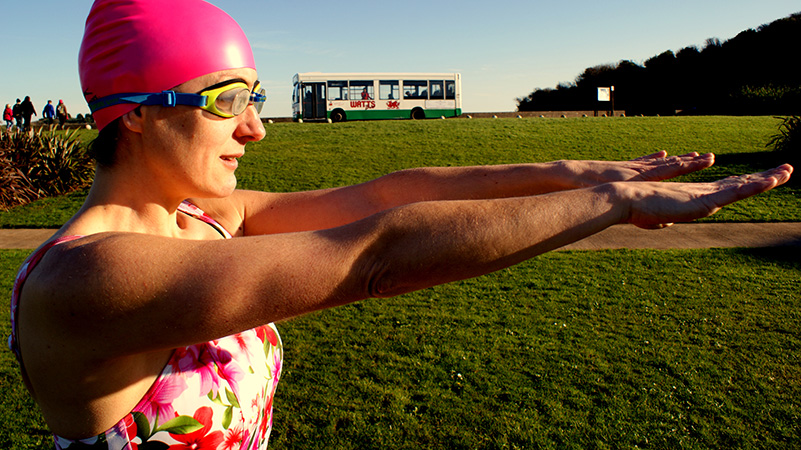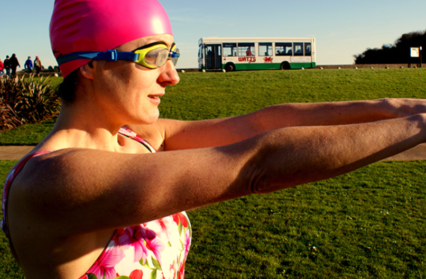Mab Jones reviews Day To Go, an immersive, theatrical tour of Barry created by Bridget Keehan and produced by Papertrail.

Directed and produced by Bridget Keehan, and co-written by Keehan and Annamarie Murphy, Papertrail’s Day to Go offers a marvellous mix of poetry and prose, story and song, set in Barry but seen from the slightly drizzle-draped and breath-misted windows of a small city bus.
Greeted at Barry Memo (now an arts centre, once a grand hall) by a friendly assistant, we were ushered aboard the bus and each given a pair of headphones. A dickie-bowed driver smiled as we clambered on and sat ourselves, switching our headgear to the required level and hearing a wash of small town sounds, intermingled with music and the odd voice, sweep into our ears. Instantly, the slightly grey and rainy scenes surrounding us became seeped in a sea of memory, melancholy, and the sense of a magic that once was.
Characters along our route included Kitty, left by her man and subsequently mired in madness, wandering the town dressed in full bridal gown and pelting strangers who accost her with stones that she keeps lodged in her knickers. We did not see the stones, but we did see the bride, veil streaming across the road right in front of the bus. Later, we witnessed her engaging in an imaginary, tragi-comic marriage service near the beach before spotting us and sweeping our way, like the white crest of a wave, frilly and flowing and fuelled by the tide of that previous tragedy. As with some of the other characters, she managed to board the bus, only to be handed a bouquet by the driver and, pain and confusion etched on her plain, cliff-like face, looked at us blankly before sweeping off once again.
Then there were the stories of St Barac, the saint who ‘never cared for St Cadoc’; Ivor, who, from his allotment on the hill, watches the tides, and who once saw ‘a shoal of lost breast implants’, as well as finding a treasure chest full of magical-seeming chalices; the Butlins redcoats; a mermaid; bathing suit-clad synchronised swimmers, who we witnessed dancing through fields near the Lido…
We learned of dancers, now deceased, who once top-hat-and-tailed it; and beautiful ballroom belles, dressed in glamorous gowns, now gone. There was the fishmonger, Billy Barac, descendant of the famous saint, who could ‘slice a conger eel with one swish of his knife’. There was Butlins, and the holidaymakers who came to Barry every year. Sadly, though, that time has been washed away.
What we are left with are the ‘bus shelter kids’, gull-like creatures whose lives revolve around chips, jackpots, and rollerblades. But even their little lives, which revolve around the purely physical, feel thrilling. Nowhere in this journey are judgements made. Rather, sensations and a sense of things as they were, and are, were evoked; thoughts are there, but feeling, sensing, empathising, remembering, were the main thing, and the bus took its passengers on such an up-and-down journey through the joys and disappointments of Barry’s inhabitants that it did feel more as if we were on what they call ‘an emotional rollercoaster’ – albeit a very small and gentle one, with all the slowness and gradually building momentum of the log flame.
This was a journey that allowed us to swim through the sea of a town’s past, present, and future, with wonderful ease. I felt myself sunk not only into the hidden secrets and better-known stories of the place, but into its heart, its soul, its imagination… In this year of Dylan Thomas overdrive, some might say overload, it was pleasant to participate in something that did not market itself on the back of the bard, despite some parallels between it and Dylan’s famous ‘play for voices’. Music and site-specific action all added to the tales told, in turn creating a wonderful, interwoven web of stories that somehow made people seem as important as places, and places as changeable, emotional , and ‘alive’ as people.
Impressive, and full of impressions, our bus journey ended with the repetition of a theme that had occurred throughout – that of things ‘leaving traces’, departing from this place, vanishing, dying… Submerged in stories that sang of then and now, death and rebirth, we were asked where we were headed, before it was time for our ‘day to go’? An interpretation that sent shivers down this poet’s spine, and one that I had not thought of previously. Where will I go, in this life, before the current journey ends and my ticket takes me on to the next place…?
A melodic, multi-layered, deftly designed and superbly, skilfully wrought production, I highly recommend taking this particular trip while you still can.
Day To Go
by Papertrail
Barry Memorial Hall, Barry











